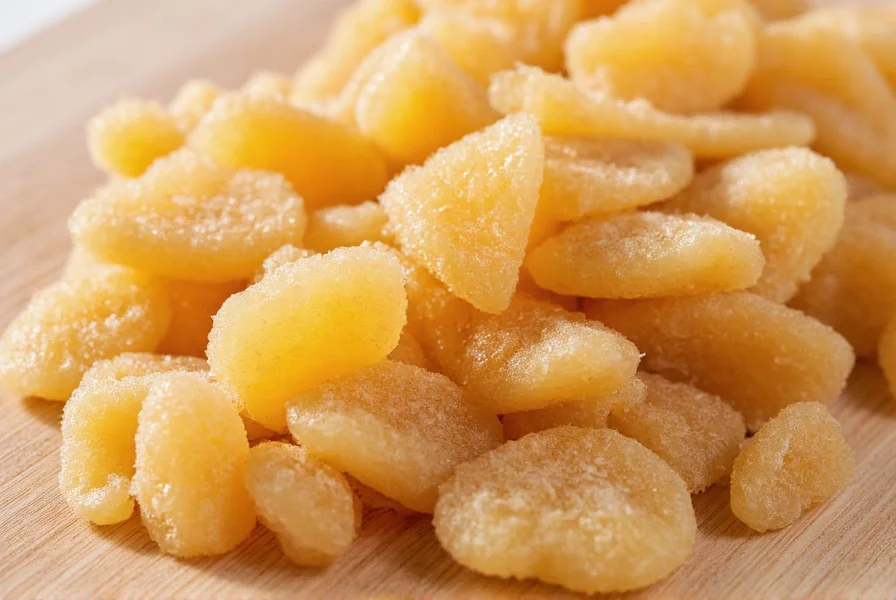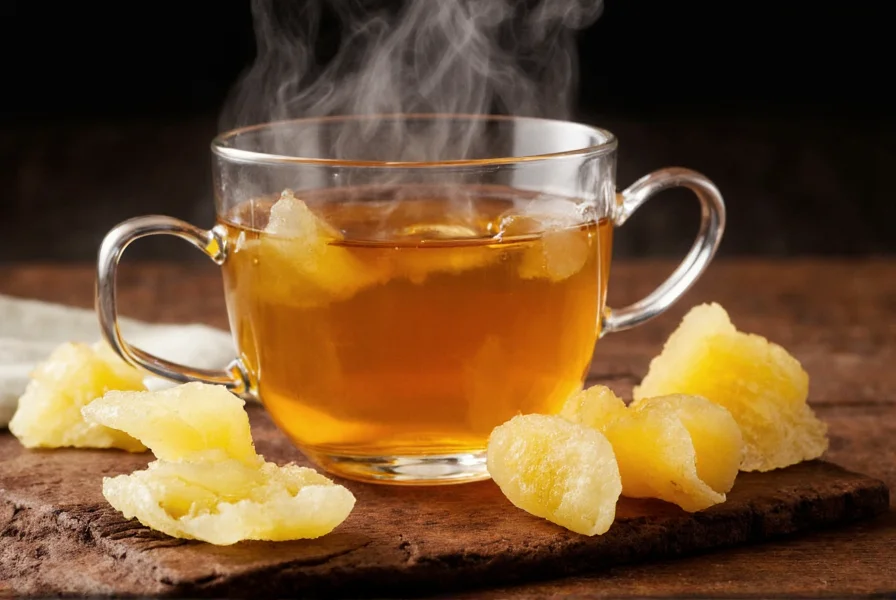Crystal ginger, also known as crystallized or candied ginger, is ginger root that has been cooked in sugar syrup and coated with granulated sugar. Unlike fresh ginger, it has a sweet-spicy flavor profile with a chewy texture, making it popular for both culinary uses and as a natural remedy for digestive issues. This preserved form retains many of ginger's beneficial compounds while offering extended shelf life and convenience.
Crystal ginger stands as a versatile ingredient bridging the gap between traditional remedies and modern culinary applications. Unlike its fresh counterpart, this preserved form undergoes a careful process where young ginger rhizomes are simmered in sugar syrup until tender, then rolled in sugar crystals. The result is a shelf-stable product with concentrated flavor and bioactive compounds that maintains ginger's signature warmth while adding a pleasant sweetness.
What Exactly Is Crystal Ginger?
The production process for crystal ginger begins with selecting young, tender ginger roots known for their thin skin and high moisture content. These roots undergo peeling, slicing, and a gradual candying process where they're simmered in increasingly concentrated sugar solutions over several days. This slow infusion allows the sugar to penetrate the ginger fibers while preserving the structural integrity of the pieces. The final step involves coating the candied pieces with fine sugar crystals, giving crystal ginger its characteristic appearance and texture.
Unlike pickled ginger which uses vinegar, or dried ginger which removes moisture, crystal ginger maintains a chewy consistency through sugar preservation. This method dates back centuries in Asian culinary traditions, where it served both as a method of preservation and as a medicinal preparation. The sugar content typically ranges from 60-70%, creating an environment inhospitable to microbial growth while concentrating the ginger's active compounds.

Nutritional Composition Compared to Fresh Ginger
While fresh ginger contains approximately 80% water, crystal ginger's composition shifts significantly due to the candying process. The sugar infusion increases caloric density while concentrating certain bioactive compounds. A comparative analysis reveals important nutritional differences:
| Nutrient | Per 1 oz Fresh Ginger | Per 1 oz Crystal Ginger |
|---|---|---|
| Calories | 4 | 110 |
| Carbohydrates | 1g | 28g |
| Sugar | 0.2g | 25g |
| Gingerols | 16mg | 22mg |
| Fiber | 0.2g | 0.8g |
The candying process actually increases the concentration of gingerols—the primary bioactive compounds responsible for ginger's therapeutic effects—by removing water content while preserving these valuable compounds. However, the significant sugar content means crystal ginger should be consumed in moderation, particularly by individuals monitoring their sugar intake.
Culinary Applications of Crystal Ginger
Chefs and home cooks value crystal ginger for its dual functionality as both flavor enhancer and textural element. Its sweet-spicy profile makes it particularly versatile across multiple culinary domains:
- Baking: Finely diced crystal ginger adds complexity to cookies, cakes, and breads, with its sugar content helping to retain moisture in baked goods
- Savory Dishes: When incorporated into glazes, marinades, or stir-fries, it provides a balancing sweetness that complements spicy or acidic elements
- Beverages: Small pieces muddled into cocktails or steeped in hot tea deliver concentrated ginger flavor without the fibrous texture of fresh ginger
- Confections: Used as an ingredient in chocolates, caramels, and other sweets where its chewy texture provides contrast
Professional pastry chefs particularly appreciate crystal ginger's consistent flavor profile compared to fresh ginger, which can vary significantly in potency depending on harvest time and storage conditions. The preserved nature of crystal ginger ensures reliable results in recipe development and production.
Evidence-Based Health Benefits
Research indicates that crystal ginger retains many of the therapeutic properties associated with fresh ginger, though the sugar content necessitates mindful consumption. The concentrated gingerols and shogaols present in crystal ginger contribute to several potential health benefits:
Multiple clinical studies have demonstrated ginger's effectiveness in managing nausea, with crystallized forms showing particular promise for motion sickness and morning sickness. A 2022 meta-analysis published in the Journal of Herbal Medicine found that participants consuming 1-2 grams of crystallized ginger experienced significant reductions in nausea symptoms compared to placebo groups. The convenience of pre-portioned crystal ginger makes it particularly practical for on-the-go nausea management.
Additionally, research suggests that the bioactive compounds in crystal ginger may support digestive health by accelerating gastric emptying and reducing inflammation in the gastrointestinal tract. Unlike fresh ginger which some find too pungent, the milder heat profile of crystal ginger makes it more palatable for regular consumption, potentially increasing adherence to therapeutic regimens.

Proper Storage Techniques for Maximum Shelf Life
When stored correctly, crystal ginger maintains quality for 6-12 months, significantly longer than fresh ginger. The key factors for optimal storage include:
- Airtight containers to prevent moisture absorption which can cause clumping
- Cool, dark locations away from heat sources and direct sunlight
- Refrigeration for extended shelf life (beyond 6 months)
- Freezing for preservation beyond one year (thaw at room temperature before use)
Signs of deterioration include excessive hardening, crystallization of the sugar coating beyond the surface layer, or development of off-flavors. Properly stored crystal ginger should maintain its characteristic chewy texture and balanced sweet-spicy flavor profile throughout its shelf life.
Creating Homemade Crystal Ginger
Producing crystal ginger at home allows for customization of sweetness level and spice intensity. The basic process requires only three ingredients and approximately one week:
- Select young ginger roots with smooth, taut skin and minimal wrinkles
- Peel and slice into uniform 1/8-inch pieces
- Simmer in simple syrup (1:1 sugar to water ratio) for 45 minutes
- Allow to cool in syrup for 24 hours
- Repeat simmering and cooling process for 3-5 days, increasing sugar concentration each cycle
- Dry pieces on wire racks for 24 hours
- Roll in granulated sugar and store in airtight containers
Home preparation offers the advantage of controlling sugar quality (using organic cane sugar or alternatives) and incorporating additional flavorings like citrus zest or spices during the simmering process. The gradual sugar infusion is crucial—rushing the process results in ginger that's either too fibrous or overly saturated with sugar.
Understanding Different Ginger Products
Consumers often confuse various ginger preparations. Crystal ginger differs significantly from other common ginger products:
- Fresh ginger: Contains higher moisture content with more volatile compounds, offering sharper heat but shorter shelf life
- Dried ginger powder: Concentrated but loses some volatile compounds during drying, with different bioavailability of active ingredients
- Pickled ginger: Preserved in vinegar solution, creating a sour profile rather than sweet-spicy
- Ginger extract: Alcohol-based concentration of ginger compounds, lacking the textural element
Each form serves different culinary and therapeutic purposes, with crystal ginger occupying a unique niche as a shelf-stable, ready-to-use product that maintains both flavor complexity and therapeutic compounds.











 浙公网安备
33010002000092号
浙公网安备
33010002000092号 浙B2-20120091-4
浙B2-20120091-4